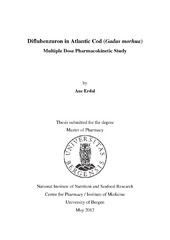| dc.description.abstract | Diflubenzuron, a chitin synthesis inhibitor, is used as a parasiticide against sea lice in farmed salmonids. It is administered orally via medicated feed pellets. Due to low bioavailability and biliary secretion of the active drug, diflubenzuron is released into the water column adsorbed to organic particles in faecal matter. Feed spills are also a source of contamination into the environment during medication periods. Consequently, there is a risk that non-target organisms could consume diflubenzuron during and after treatment periods via organic particles from sea pens. Little is known about the pharmacokinetics of diflubenzuron in non-target fish species. In this study, the standard diflubenzuron treatment (3 mg/kg once daily for 14 days) has been administered to Atlantic cod with a mean weight of 104 g (lower and upper bounds 65 and 165 g) at a water temperature of 7.7 °C, and samples of fillet and skin in natural proportions, liver, terminal colon and bile have been collected during and in the period following the medication period (day 4, 8, 12, 15, 18, 22, 29, 36 and 44). The primary objective has been to determine the tissue levels of diflubenzuron obtained in Atlantic cod, as well as the depuration half lives in the different tissues, through HPLC/MS. A secondary objective of this study was to evaluate whether PCA, a toxic metabolite of diflubenzuron, is formed in Atlantic cod, through qualitative HPLC/MS/MS analysis of fillet and skin samples. During the medication period, the calculated tissue levels in fillet and skin and liver showed high variability. This is probably due to individual differences in feed consumption, and to a lesser extent differences in absorption. The median tissue levels obtained in fillet and skin and liver were 36.1 and 106 ng/g, respectively. This is very low compared to Atlantic salmon, in which a mean concentration of 2240 ng/g in fillet and skin has been found at 6 °C 1 day after standard treatment (EMEA, 1999). Furthermore, no fillet and skin samples throughout the medication period exceeded the MRL value of 1000 ng/g. There was a high uncertainty in the calculated depuration half-lives due to low tissue concentrations and high variation between samples, but all half-lives were less than 1 day. PCA was not detected in any of the fillet and skin samples throughout the medication period at a LOD of 2 ng/g. In terms of consumer safety, there appears to be little risk associated with the consumption of wild caught Atlantic cod that may have fed on spills of medicated feed from sea pens during diflubenzuron treatment, because diflubenzuron seems to have a low gastrointestinal uptake in Atlantic cod, and the toxic metabolite PCA was not detected in fillet and skin samples. | en_US |
